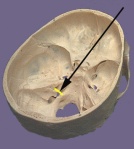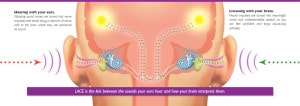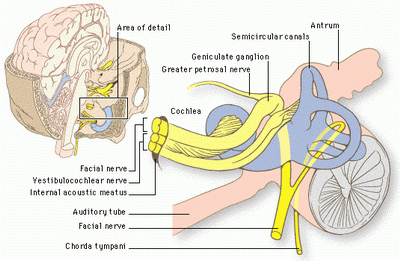This post is about how the auditory nerve (cranial nerve VIII, officially called vestibulocochlear CNVIII) hooks up our inner ears to our brains and things that go wrong at the point of hook up. For example, vascular loops inveigle themselves into the hook up intersection, causing traffic jams which interrupt the flow of hearing to the brain. Shingles is another source of traffic disruption to be discussed in future posts.

Figure 1. Vestibulocochlear nerve Enters the Brainstem
Grand Central Station
Today’s post is a brief anatomy lesson to help patients and other readers understand the hook up point of the hearing nerve with the brain. We won’t get fancy — most of this comes from Wikipedia. Nevertheless, it can be confusing because everything is so tiny and packed so tight.
The vestibulocochlear nerve connects the ear to the brain in an area called the brainstem. It does this by coursing through a very short, tiny tunnel called the internal auditory meatus that opens into the brain (see Fig 1). Although it’s not shown in the figure because there’s not enough room, keep in mind that there’s a duplicate tiny tunnel and vestibulocochlear nerve coming into the brainstem from both sides — left and right ears. Evolution came up with this long before integrated circuits were invented.
Take the A Train
These tiny tunnels on left and right serve are Grand Central for a lot of neural processing:
- The auditory (cochlear) nerve receives and transmits input from the hearing part of the inner ear (cochlea) to the brainstem;
- the vestibular nerve receives and transmits input from the balance portion of the inner ear (semi-circular canals) to the brainstem;
- the facial Nerve (cranial nerve VII) receives input (sensory branch) and sends output (motor branch) that control facial expression and some taste function. Along the way, it also sends a tiny motor branch to control the stapedius muscle of the middle ear.
- the anterior inferior cerebellar artery provides the blood supply to the inner ear.
As you can tell from the paths, the vestibulocochlear nerve is two separate nerves bundled together, and the facial nerve is also sandwiched in next to that bundle. Fig. 2 shows the three nerves crunched together tightly in the middle (in yellow).
What the figure doesn’t show is that they are crunched so tightly because they are going through that tiny, short bony tunnel. The two “sensory branches” of the vestibulocochlear nerve are going UP from the ear to the brain; the “sensorimotor” facial nerve is going UP and DOWN between the brain and the face, tongue and middle ear.
The point of going through the anatomy is to emphasize how precise the wiring and utilities are in the ear-brain housing. And, just like the houses we own and live in, we all know that errors, accidents and disasters happen: materials are substandard, wires short out, fuses blow, pack rats move in, trees fall on the roof, flooding occurs. Analogous things can occur in our tiny auditory tunnels as well. We’ll be writing more about them, starting with Shingles in the auditory system next week.
Top diagram courtesy of LACE at Sound Solutions Hearing







